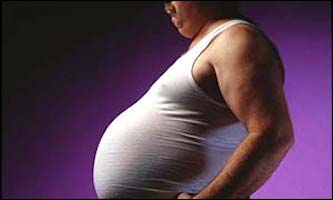
Source: news.bbc.co.uk
I was in a restaurant many years ago drinking my carrot juice while a young friend of mine happily bottoming up his beers made a striking remark, ‘I have to do this, so that I will have a big tummy and people will know that I am a prosperous young man’. He glanced at me and said wryly, ‘big tummy means prosperity.’ I thought to myself, ‘well at least he knows that drinking beer causes abdominal obesity’. What my friend did not know then was that abdominal obesity is also associated with heart diseases and early death.
My friend was not alone. Statistics shows that in most communities, one out of three adults have abdominal obesity with varying degrees of severity. Apparently the people who are affected by this condition are getting younger in every generation. Deep in our subconscious level, we know that having a bigger belly is somehow undesirable both for cosmetic as well as health reasons. We try to numb this effect by calling big tummy as cute, spare tire, love handle, prosperity sign and so on. This unease may have something to do with how dangerous a big belly could be to our health.
A study was done and published in 2007 on 160 000 patients assessing the association between waist circumference and heart diseases and diabetes. The result shows a significant link between increased waist circumference and the existence of heart diseases and diabetes in both genders. What is even more shocking, even the slightest increase in waist circumference among lean patients (Body Mass Index, BMI < 25) is also associated with increased risk of developing heart diseases and diabetes. Various similar studies before and after have confirmed the finding.
That means, a big belly is not only unsightly, it is deadly!
Desirable waist circumference for men should be below 90cm and for women is 80cm in Asian community. This is stipulated in Malaysian Clinical Practice Guidelines for Obesity 2004. This may sound too distant for most people but waist circumference is actually very close to the size of your pants. Of course, if you are wearing your pants below the waist line, this does not apply. Unless you are one of those teenagers who love to wear their pants well below their waist, wearing pants in such way means your tummy is already bulging out. Ask yourself this simple question, ‘what is the size of my pants?’ If you are an Asian male and the size of your pants is more than 90cm, the chances are, you will die sooner than your leaner friend. It is a sobering fact, but it is totally modifiable.
Increase in waist circumference or abdominal girth is not simply due to overeating and being fat. In fact there are people who are skinny all over and yet have a protruding tummy. It is also quite common to hear or see a person who is on dietary restriction and has developed muscle wasting (shrunken cheek and flat chest) and yet that tummy is still bulging out.

Source: www.thejournal.ie
The development of abdominal obesity is due to a complex combination of wrong food intake, sedentary lifestyle, nutritional deficiencies and hormonal imbalance. Correcting only one of these factors may not shed the fat in the tummy. One can hit the gym for hours daily and develop muscles all over his or her body and yet still has his or her belly protruding out. Those of us who have frequented gyms can testify to this not so uncommon sight.
As an anti-aging practitioner, experience dictates that the most important factor in reducing abdominal girth is balancing our hormones to a youthful level. The most important hormone involved for men is testosterone and for women is finely balanced testosterone, progesterone and estrogen. In fact, there is a joke among anti-aging practitioners that says if a man standing naked and unable to see his penis without bending, he is definitely testosterone deficient (his bulging tummy already obscuring the direct line of view).
In conclusion, the bigger the size of your belly the more likely you will develop heart diseases and diabetes. Both of which contribute to the highest cause of mortality for human.
Back to the story above, my friend who was aspiring to be a prosperous young man is sadly no longer around. He was diagnosed with liver ailments last year (2012) and died soon after. However, in consolation, he died having a big tummy and was relatively a prosperous man.
To all readers out there, you do not have to drink beer to have a big tummy. No matter what the reason is for your big tummy, it will cause you to have chronic illnesses such as heart diseases and diabetes and may eventually kill you. Do all you can at all cost to reduce that unsightly and deadly big tummy.
This article was written by the Malaysian Medical Gazette’s permanent columnist Dr. Rizin H Kusop who is currently the proprietor and MO in charge of a group practice franchise in Sabah who has a special interest in Anti-aging, Regenerative and Aesthetics medicine. Find out more about him at The Team page.
[This article belongs to The Malaysian Medical Gazette. Any republication (online or offline) without written permission from The Malaysian Medical Gazette is prohibited.]
References:
- Balkau, B et al. International Day for the Evaluation of Abdominal Obesity (IDEA). Circulation. 2007; 116:1942-1951.
- Kuk, JL et al. Visceral fat is an independent predictor of all-cause mortality in men. Obesity. 2006; 14:336-341.
- Malaysian Clinical Practice Guidelines on Management of Obesity. Ministry of Health Malaysia. 2004.
- Chu, LW et al. Serum Total and Bioavailable Testosterone Levels, Central Obesity, and Muscle Strength Changes with Aging in Healthy Chinese Men. Journal of the American Geriatrics Society. 2008; 56(7):1286-1291.
- Svartberg, J et al. Waist Circumference and Testosterone Levels in Community Dwelling Men. European Journal of Epidemiology. 2004; 19(7):657-663.
